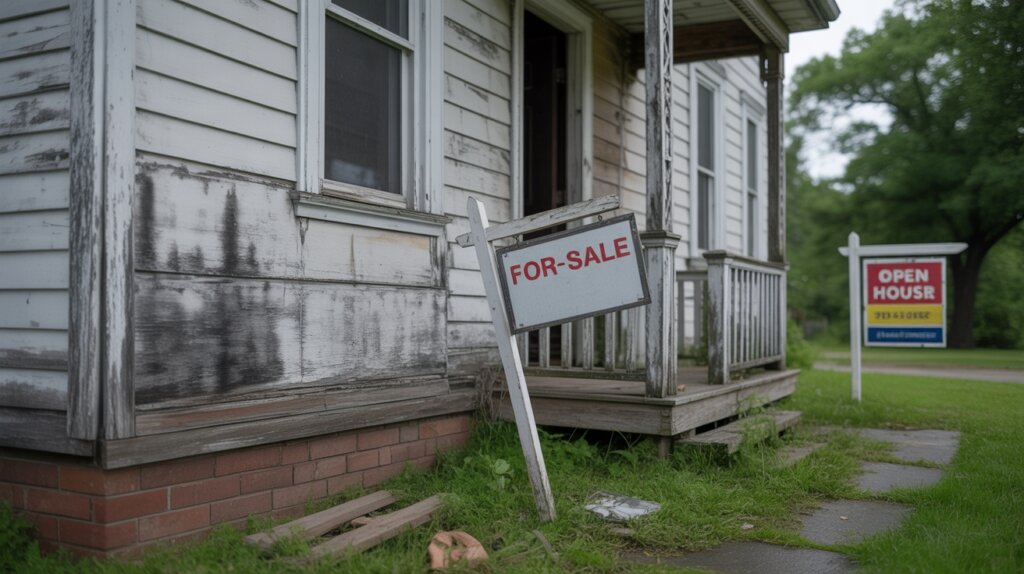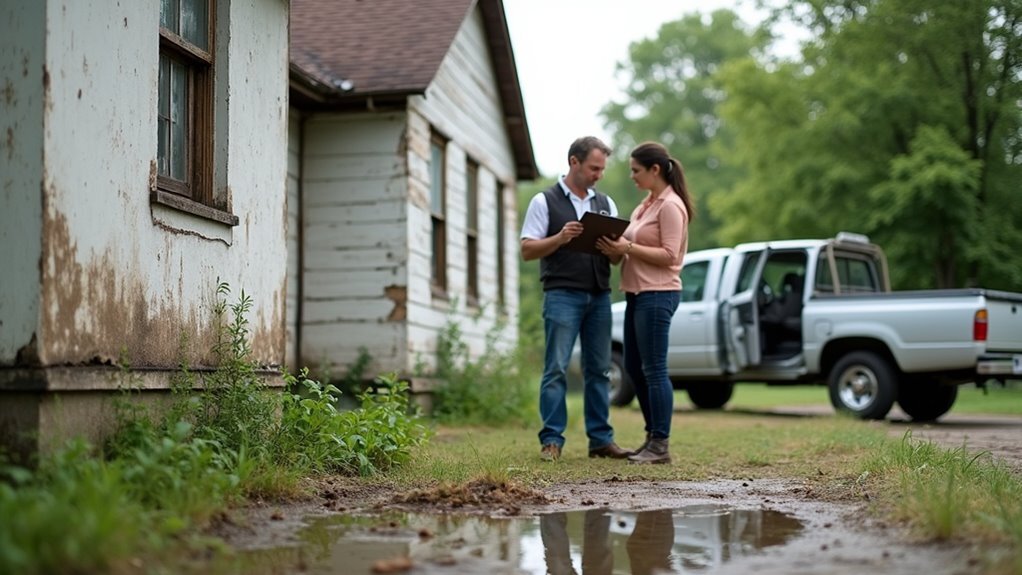Selling a house with mold or water damage is challenging. Most buyers shy away from properties needing major repairs. Homeowners often feel stuck with a home they cannot sell.
The longer a property sits unsold, the worse the damage can get. Repair costs may also rise, causing more stress and worry. Owners may feel trapped and unsure where to turn for help.
You can find cash buyers for a house with mold or water damage by targeting investors who seek distressed properties. These buyers look past visible flaws and focus on potential value.
Using the right approach connects you with people ready to buy quickly. This blog will guide you step by step to find the right cash buyer for your damaged house.
Key Takeaways
- Join local investor groups, auction events, and online real estate forums to connect with buyers specializing in distressed or damaged properties.
- List the property on investor-focused platforms like Zillow, Redfin, or specialized cash buyer websites with clear disclosures about mold or water damage.
- Partner with experienced real estate agents or wholesalers who have established networks of cash buyers for homes in need of repairs.
- Provide detailed inspection reports, repair estimates, and transparent disclosures to attract serious investors and build trust in the transaction.
- Verify buyer credibility by requesting proof of funds and checking their experience with similar damaged properties to ensure a smooth closing.
Understanding the Market for Damaged Properties

Selling a property with mold or water damage reduces your number of buyers. However, there is a market for these damaged homes. Investors, flippers, and cash buyers often look for such properties.
These buyers know how to assess risk and renovate homes for profit. Damaged properties usually have lower prices, which attracts these buyers. If you price your home realistically, you may sell faster.
Current trends like low inventory or demand for fixer-uppers can help your sale. Data shows distressed sales make up over 15% in some cities. If you understand what buyers want, you can market your property better.
Additionally, understanding the potential impact of liens and legal considerations can be crucial when dealing with distressed properties, especially if there are existing liens or legal complications, which could influence the sale process.
Recognizing the importance of property condition assessments can help you better communicate the property’s value and repair needs to potential buyers.
Evaluating the Extent of Mold or Water Damage
You need to systematically identify visible damage indicators like staining, odors, and warped materials to document the scope of the issue. Assess the property’s structural integrity, focusing on compromised framing or foundation components that could impact value.
Use industry-standard cost estimators to calculate repair expenses, providing cash buyers with transparent, data-backed projections. Additionally, inspecting for signs of water intrusion such as mold growth or water stains can help determine the severity and cause of damage.
Identifying Visible Damage Signs
When looking for visible damage, check for water stains and discoloration on walls or ceilings. Peeling paint, warped floors, and mold spots are clear signs. If you notice these, there may be water or mold damage.
Baseboards, window sills, and under sinks often collect moisture. Soft drywall or bubbling paint also suggest water problems. These signs mean you should inspect further.
A musty smell can show that mold is hidden behind walls or floors. Mold can start to grow within 24 to 48 hours after water appears. If you find damage, document everything carefully.
This record will help estimate repair costs. It also helps you explain the property’s condition to buyers or repair workers. If you spot any of these signs, act quickly to prevent further damage.
Assessing Structural Integrity
Check the property’s structure if you see water or mold damage. The building may be weakened and need repairs. If the structure is unsafe, you might have to fix it before selling.
Inspect the foundation for cracks, settling, or movement. These signs may point to damage from moisture. If you find these issues, repairs may be needed.
Look at floor joists, beams, and walls for signs of rot or warping. These problems can lower the strength of the home. If these parts are soft or bent, their ability to hold weight is reduced.
Use moisture meters or infrared cameras to find hidden water. If moisture is present, structural parts could be at risk. Early detection can prevent bigger problems.
A careful check gives buyers honest information. If major repairs are needed, it is best to know before selling. This helps everyone avoid surprises.
Estimating Repair Costs
Repair costs for mold or water damage depend on how much of the property is affected. You should inspect and document all damage, including walls, floors, and air systems. If you want an accurate estimate, hire certified professionals to assess the situation.
National averages for mold cleanup range from $1,500 to $6,000. If the damage is ignored, costs will likely increase. You also need to include materials, labor, and disposal fees in your calculation.
If your insurance covers this type of damage, you might pay less out of pocket. Always review your policy before starting repairs. Accurate estimates help you set a fair price and attract serious buyers.
Determining Your Home’s As-Is Value
Severe mold or water damage lowers your home’s value. If you want cash buyers, first find out your home’s as-is value. This will help you set a fair price.
A professional home inspection shows the extent of mold or water issues. Inspectors report on structural damage and contamination. If problems are found, your home’s value will likely decrease.
Written repair estimates from certified contractors show how much fixes may cost. These estimates should cover mold removal and water damage repairs. If you have the repair costs, you can adjust your home’s value.
Start by finding the average sale price of similar homes nearby. Deduct the cost of needed repairs from this amount. If there could be hidden damage, lower your price further to account for buyer risk. Check local home sale prices, subtract repair costs, and adjust for hidden damage to find your property’s true as-is market value.
This step-by-step approach helps you find a realistic as-is value. Accurate pricing attracts serious cash buyers. Additionally, understanding the repair costs involved enables you to negotiate more effectively and set realistic expectations with potential buyers.
Preparing Essential Documentation

Thorough documentation is important when selling a house with mold or water damage. Good records help buyers trust you and make the sale smoother. If you prepare the right paperwork, you can speed up the process.
A licensed inspector should complete a home inspection report. The report must show the level of water damage, mold types, and repair estimates. If you include these details, you will help buyers understand the true market value of the property.
Repair invoices and contractor statements prove what work got done. Utility bills and maintenance records show you have cared for the home. If buyers see this information, they may feel more confident.
Legal documents are also needed. These may include property disclosures, insurance claims, and compliance certificates. If your area has special rules, you should check what forms are required.
Having comprehensive property documentation can significantly reduce delays and facilitate a smoother transaction process. Well-organized records help buyers finish their checks faster. If you provide everything upfront, you may avoid delays or extra questions. Proper paperwork also reduces arguments during negotiations.
Disclosing Damage to Potential Buyers
You must tell buyers about any mold or water damage before selling your property. Most states require you to share this information by law. Clear disclosure helps avoid legal problems and builds trust with buyers.
You should provide inspection reports that show the condition of the property. These reports should include any mold or water damage found by professionals. Buyers can then see the facts for themselves.
If you fixed any problems, list the repairs and give the dates and names of the contractors. This helps buyers understand what work has been done. They can feel more confident in the property.
If there are still issues or risks, you must mention them. Buyers need to know if more repairs or monitoring are needed. Honest information makes the sale process smoother.
Being transparent about property condition issues and potential legal complications is crucial to maintain trust and avoid future disputes. Additionally, providing documentation of inspections and repairs can further reassure buyers about the property’s true state.
Connecting With Local Real Estate Investors

Local real estate investors often buy homes with mold or water damage. They purchase properties as-is, no matter the condition. If you want to connect with these investors, you need to know your property’s value and the local market. Understanding the property’s market analysis and pricing trends can greatly improve your chances of a successful sale.
Investors look at the property’s after-repair value and the cost to fix it. You should prepare estimates for repairs and gather documents to show these numbers. If you give clear prices using recent sales, you will have better talks with investors. Check local sales data to find investors who buy damaged homes.
You can also meet investors at real estate events or foreclosure auctions. If you show honest information and fair prices, you are more likely to find serious buyers. Additionally, understanding property condition and how it influences value can help tailor your approach and negotiations with potential cash buyers.
Utilizing Real Estate Investment Networks
Real estate investment networks help you find more cash buyers for homes with mold or water damage. These networks include investor groups, professional clubs, and online forums. If you use them, you can reach buyers who already understand property repairs.
Establishing a reasonable price can also make your property more attractive to serious investors. You should join national and local real estate investment clubs to access their buyer lists. If you attend seminars or local events, you can show your inspection results to interested investors. Property data and damage reports can attract serious buyers if you share them clearly.
If you work with wholesalers, you can reach buyers looking for damaged properties. Wholesalers often have cash buyers ready to close quickly. Understanding property damage can help you present your home more effectively to potential investors, increasing your chances of a quick sale. If you want fast sales, this is an effective option.
Leveraging Online Platforms for Cash Buyers
Online platforms help you find serious cash buyers for homes with mold or water damage. These sites reach more people than traditional methods. You can quickly connect with buyers who want distressed properties. A fast sale can be achieved through these online avenues, especially when urgency is paramount.
Utilizing title search and resolution tools on these platforms can further verify buyer credibility and streamline the transaction process. Web sites like Zillow and Redfin let you target investors looking for cash deals. Real estate forums also gather buyers interested in damaged homes. If you use data filters, you can sort users by cash transaction history. Virtual home staging can make damaged homes look better online.
High-quality photos and clear disclosures build trust with buyers. If you do this, you increase your chances of closing a sale. Industry reports show over 60% of investors find leads online. A strong digital presence is essential for success today. Online tools help you reach buyers who are ready to close quickly.
Marketing Your Property Effectively
Effective marketing is essential to attract serious buyers for your property. Clear communication of your property’s strengths and weaknesses is necessary. Investors look for value, so give them the facts they need.
Always disclose any damage and estimated repair costs. If you hide mold or water issues, you risk legal problems and lose buyer trust. Full honesty helps you avoid future disputes. Disclose all damage and repair costs—honesty builds trust and protects you from legal trouble and future disputes.
Professional photos make your property stand out, even if it needs repairs. Simple home staging can show potential and increase appeal. Staged homes often sell much faster, even in as-is condition.
Check that your marketing materials follow all disclosure laws. If you are unsure, consult a legal expert. Proper compliance protects you from liabilities.
Additionally, providing a thorough inspection report can reassure buyers and facilitate a quicker sale. If you market your property well, you reach more buyers and increase your chances of a quick sale.
Contacting “We Buy Houses” Companies
“We Buy Houses” companies offer a fast way to sell a damaged home. These companies buy houses as-is, so you do not need to fix mold or water damage first. This option helps you avoid spending money on repairs.
Most of these companies have experience with homes that have major problems, like mold and water damage. If you need to sell quickly, they can give you a cash offer after a short inspection. Their process often skips traditional bank loans and long negotiations.
If you are clear about the home’s condition, you are more likely to get a fair offer. Being honest helps prevent delays or price changes later. If you want to save time, this method keeps your house from sitting on the market.
Working With Real Estate Agents Who Specialize in Distressed Homes
You’ll want to identify local real estate agents with a proven track record in distressed property transactions and access to cash buyer databases.
Utilize their extensive networks to accelerate exposure and target investors seeking properties with mold or water damage. Negotiate agent commission rates upfront to preserve your net proceeds, as industry data shows rates can vary significantly in these specialized transactions.
Identifying Local Expert Agents
To find a local expert agent, look for someone with experience in selling homes with mold or water damage. The right agent can help you reach cash buyers fast. If you choose correctly, you will have a smoother selling process.
Check agent portfolios for past sales of damaged homes. Ask for references from local contractors. If an agent works with trusted contractors, they likely know how to handle repairs.
You should also see if the agent works closely with property inspectors. Good agents use inspectors to give honest home assessments. This helps buyers feel more confident about the property.
If you follow these steps, you will find an agent who understands your needs. The right expert will use data to set a fair price. They will also know the local market for homes needing repairs.
Leveraging Agent Networks
A knowledgeable agent can connect you with buyers for distressed homes. Agents often know investors who want properties with mold or water damage. If you work with these agents, you can find buyers quickly.
Ask your agent to check recent sales of similar homes in your area. This helps you price your house correctly. If your agent suggests a price, consider it to attract more buyers.
You can also discuss simple ways to stage your home, even if it has damage. Staging helps buyers see the property’s potential. If your home looks inviting, buyers may offer better prices.
Rely on your agent’s network and advice to make the sale process easier. This teamwork increases your chances for a fast, as-is sale. If you follow these steps, you are more likely to find a serious cash buyer.
Negotiating Agent Commission
Agent commissions can lower your final profit. You should discuss commission rates before hiring a real estate agent for distressed properties. Lower commissions are often possible in these situations.
Agents with experience in mold or water damage know how to handle inspection reports. Their knowledge can help you with legal disclosures. This expertise can protect you during the sale.
You can ask for a sliding commission scale. If the property needs a lot of repairs, you can use this to request a lower rate. Providing inspection details can support your request.
Make sure your agent understands legal requirements for disclosures. This reduces your risk and helps the sale go smoothly. If you use clear information in these talks, you can keep more of your money.
Screening and Qualifying Potential Cash Buyers
Screening and qualifying cash buyers is essential before selling a home with mold or water damage. Sellers should always check that buyers have proof of funds. This helps confirm buyers can pay without needing a loan.
Proof can include recent bank statements or a certified letter from the bank. Buyers should also complete their own property inspection. This helps them understand the full extent of the mold or water issues.
Request recent bank statements or a certified bank letter, and advise buyers to inspect the property to assess mold or water damage.
If a buyer has experience with damaged homes, they are more likely to finish the deal. Sellers should check each buyer’s background with similar properties. Reliable buyers reduce the risk of last-minute cancellations.
A real estate attorney can help with legal rules and paperwork. If sellers need guidance on disclosures or liability, the attorney can advise. Following state and federal laws protects all parties during the sale.
Negotiating Offers and Terms
You need to set data-informed price expectations by analyzing comparable distressed property sales and factoring in remediation costs.
Cash buyers typically require as-is sale terms, so you should prioritize clear contract language to limit post-sale liabilities. Utilize market analytics to negotiate from a position of strength while maintaining transparency about the property’s condition.
Setting Realistic Price Expectations
Setting realistic price expectations means using facts to guide your decision. Check market data, repair costs, and the damage level. Price the home lower if issues affect its look or condition.
Compare recent sales of similar homes needing repairs. Adjust the price based on how much work the property needs. If you know the repair costs, subtract them from the expected value after repairs.
Buyers will want a lower price if they must fix mold or water damage. Cash buyers, in particular, expect a discount for taking on these risks. Set your price to reflect these facts and attract serious buyers.
Navigating As-Is Sale Terms
Selling a house with mold or water damage usually means you sell it “as-is.” This means you will not make repairs. Buyers will consider repair and cleanup costs when making offers.
Cash buyers often offer 20-30% less for homes needing major repairs. You should have inspection reports and repair estimates ready. These documents help you answer questions and keep the process clear.
Always check any conditions in the offers you get. Some buyers might skip inspections to close faster. Others may ask for a lower price after inspecting the property.
If you want the best deal, answer questions quickly and compare several offers. Make sure all as-is terms are clear in writing. This will help prevent problems after you sign the contract.
Navigating the Closing Process With a Cash Buyer
Selling to a cash buyer usually makes the closing process faster and simpler. You will not face loan approvals or many negotiations. If your property has mold or water damage, certain important steps remain.
A property inspection is still necessary before closing. Buyers may want to see the inspection results to understand the extent of any damage. If you skip this step, buyers might lose trust or back out.
You must share all known issues with buyers as required by law. Full disclosure helps you avoid legal troubles later. Missing this step could lead to penalties.
If you coordinate with the buyer and title company, the closing can happen quickly. Completing each step on time ensures a smoother sale. Taking these actions lowers risks for both parties.
Conclusion
If you want to sell a house with mold or water damage, understanding the process is important. You should always gather documentation and know the extent of any damage. If you prepare well, you can avoid surprises and get better offers.
If you need a fast solution, companies like us buy houses for cash, even with damage. We use investor data and our experience to give fair offers. If you choose to sell as-is, you can save time and stress.
If you are ready to sell your house quickly, Greg Buys Houses can help. We buy houses for cash in any condition. Contact us today to get started and see how simple selling your home can be.

